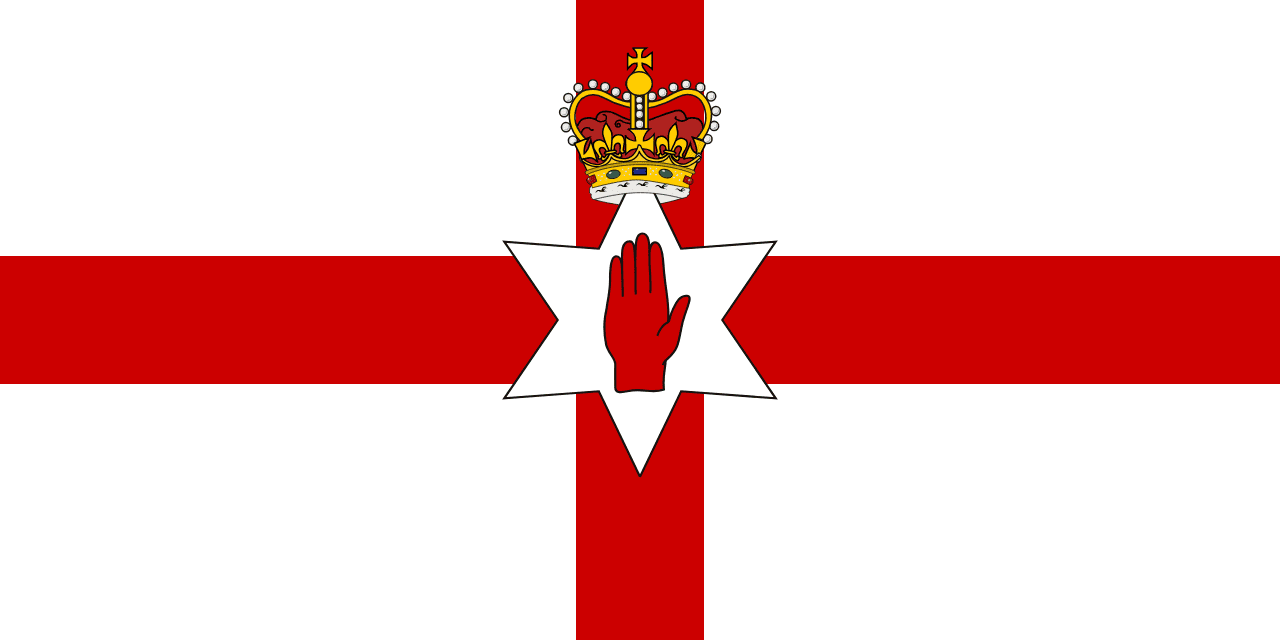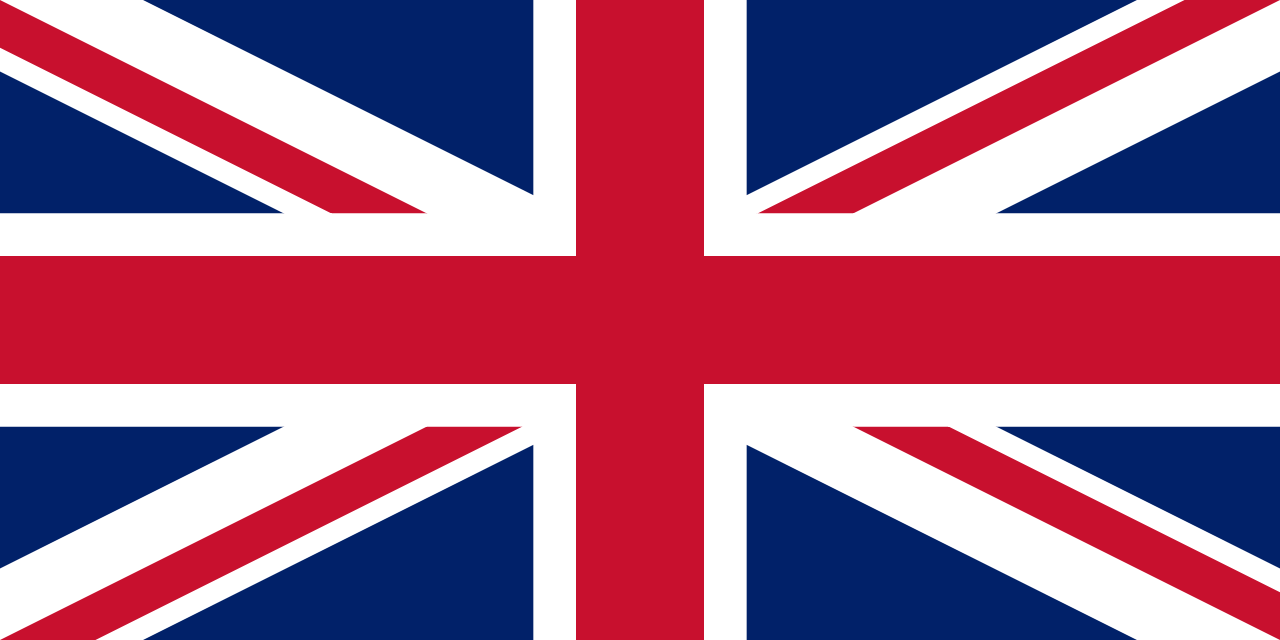Northern Ireland Flag Meaning
The Ulster Banner - featuring the Red Hand of Ulster on a white field with the Union Jack canton and crown, served as Northern Ireland's official flag from 1953-1972 and remains in unofficial use today.
- Continent
- Europe
- Adopted
- 1953
- Ratio
- 1:2
- Colors
- white, red, yellow

Symbolism
Red Hand of Ulster: Ancient symbol of Ulster province, representing the legendary race to claim the land where the winner cut off his hand to be first to touch the shore, symbolizing determination and Ulster identity.
Six-Pointed Star: Represents the six counties of Northern Ireland (Antrim, Armagh, Down, Fermanagh, Londonderry, and Tyrone) that remained part of the United Kingdom after partition in 1921.
St. Edward's Crown: Symbolizes Northern Ireland's connection to the British monarchy and the United Kingdom, representing loyalty to the Crown and British constitutional tradition.
Union Jack Canton: The small Union Jack in the upper left corner emphasizes Northern Ireland's status as part of the United Kingdom and connection to British identity.
White Field: Represents peace and purity, serving as the background that allows the other symbols to stand out prominently and clearly.
History
- Ancient Times: The Red Hand of Ulster appears in ancient Irish mythology and heraldry, predating Christian Ireland and representing the ancient kingdom and province of Ulster.
- 1921: Northern Ireland was created through the Government of Ireland Act, partitioning Ireland and establishing Northern Ireland as a separate Home Rule territory within the United Kingdom.
- 1924-1953: Northern Ireland used various unofficial flags and the Union Jack for official purposes, lacking a distinctive territorial flag during its early decades.
- May 29, 1953: The Ulster Banner was officially adopted by the Northern Ireland government as the official flag, incorporating traditional Ulster symbols with British monarchical elements.
- 1972: Direct rule from Westminster was imposed and the Northern Ireland Parliament was suspended, ending the official status of the Ulster Banner as the territorial flag.
- 1972-Present: Northern Ireland has no official flag; the Union Jack is used for official government purposes, while the Ulster Banner continues in unofficial use, particularly in sports.
- 1998-Present: The Good Friday Agreement established new governance structures, but no agreement was reached on official symbols, leaving the flag question unresolved.
Trivia
- Northern Ireland is one of the few territories in the world without an official flag, relying on the Union Jack for official government purposes since 1972.
- The Ulster Banner is still used by the Northern Ireland football team and the Commonwealth Games team, despite having no official status.
- The Red Hand of Ulster appears in the heraldry of both the Republic of Ireland (Leinster province) and Northern Ireland, representing the ancient province's shared heritage.
- The flag's design incorporated elements from the coat of arms of Northern Ireland, which was granted by the College of Arms in London in 1924.
- During The Troubles, the Ulster Banner became associated with unionist identity, while nationalist communities favored the Irish tricolor, making flag displays politically sensitive.
- The six-pointed star is sometimes called the Star of David, though its use here represents the six counties rather than having any Jewish religious significance.
- Some loyalist areas display the Ulster Banner alongside Union Jacks and other British flags, particularly during the summer marching season.
- The flag appears on Orange Order banners and in loyalist murals throughout Northern Ireland, maintaining its cultural significance in unionist communities.
- FIFA and UEFA allow Northern Ireland to use the Ulster Banner for football matches, despite its lack of official status since 1972.
- The crown depicted is specifically St. Edward's Crown, used in British coronations, rather than the more commonly seen Tudor Crown used elsewhere.
- Attempts to create a new agreed flag for Northern Ireland have failed due to the deep political divisions over symbols and identity.
- The Ulster Banner flew over Stormont Parliament Buildings from 1953-1972, and replicas are still displayed in loyalist areas on important dates.
- Some versions of the flag include a yellow border around the star, though this isn't part of the official design specifications.
- The flag's design influenced several Orange Order lodge banners and remains important in Protestant/unionist cultural traditions and parades.
- Unlike other UK territories, Northern Ireland's complex political situation means any new official flag would require cross-community agreement, which has proven elusive.
Related Countries

Ireland
Europe
Three equal vertical stripes of green, white, and orange, representing the hope for peace between the Catholic and Protestant communities of Ireland, with the tricolor symbolizing unity and the aspiration for a harmonious Irish nation.

United Kingdom
Europe
The Union Jack combines the crosses of Saint George (England), Saint Andrew (Scotland), and Saint Patrick (Ireland) on a blue field, representing the political union of England, Scotland, and Ireland under one crown, though Wales is not directly represented in the flag design.

Scotland
Europe
The Saltire - white diagonal cross of Saint Andrew on azure blue field, one of the world's oldest national flags.

Wales
Europe
Y Ddraig Goch - the red dragon passant on green and white horizontal field, representing Welsh heritage and Celtic identity.

Netherlands
Europe
A horizontal tricolor of red, white, and blue, the oldest tricolor still in use today. It originated in the 16th century during the Dutch Revolt against Spain.

Belgium
Europe
Three vertical stripes of black, yellow, and red derived from the coat of arms of the Duchy of Brabant, adopted during Belgium's independence revolution and representing the nation's determination, generosity, and sacrifice.